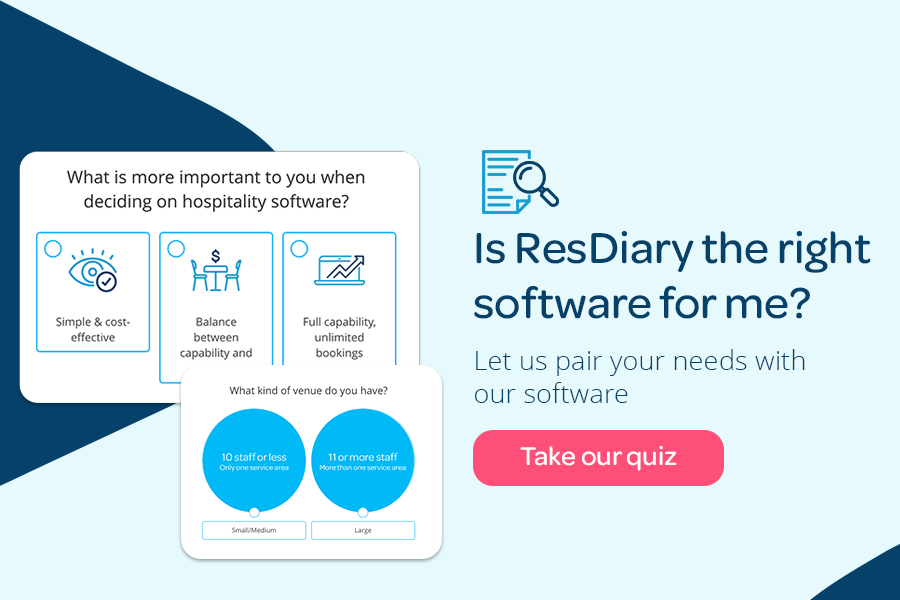Maximising restaurant bookings over a lunch or dinner can be a tricky thing for managers to navigate. Trying to fit in as many bookings as possible within a narrow time window while still prioritising quality customer service is a difficult balancing act.
The space in which your bookings are being seated, served and enjoyed is an important factor to consider. Being conscious of floor plan, seating arrangements and the magnitude of bookings can contribute heavily to the success of the day's yield.
Proper yield management means being able to juggle space capacity without overwhelming kitchen and staff while still promoting quick and reliable service. For many restaurant managers and owners, venue floor space is still an untapped haven for introducing great strategies that can improve both business profits and customer satisfaction.
Here are our top yield management strategies that utilise your venue's floor plan for improvement:
Utilising Floor Space
The first step to improving venue capacity and capability is through utilising your floor space. By improving how servers, customers and staff move through your venue, you'll be able to provide better and quicker service, allowing for increased bookings (and therefore increased revenue).
This could include a number of different improvements, such as updating your floor plan for better movement throughout the venue or even simply enhancing customer experience with natural lighting.
Optimal walking zones
Having optimal walking zones within a restaurant venue means that there is no floor traffic or congestion when serving and waiting upon customers. Your current gross floor area where your guests are seated should have distinct pathways in which your servers and staff can easily weave through. This will ensure that reliable customer interaction is prioritised and employees can work effectively during their shift.
An optimal walking zone layout is easily achieved by mapping out the entries, exits and areas of the venue that are most frequently used as pathways. Here is an example of applying optimal working zones to your floor plan:

As you can see from the diagram, the optimal walking zones for staff, highlighted in green, should be defined walkways that are used every time a staff member needs to go out on the floor. The highlighted red sections are frequently used customer zones, which should be bypassed by staff to ensure congestion is kept to a minimum.
If you're starting from scratch with your floor planning, the best way to utilise this strategy is by working with an interior designer who understands commercial space.
Create flexibility
Creating flexibility in your establishment is integral for successful service. Each day in the hospitality industry is unique, with different booking sizes, walk-ins and group event bookings altering how service will look.
Just as you adjust an employee schedule to have the right amount of staff, you should be altering your gross floor area to cater for different tables and customer interactions.
Making sure your space is flexible to fit large or unusual bookings may come down to simple strategising such as having foldable chairs and tables that move easily. If private events or group bookings are available at your venue, having movable partition walls separating bookings may be a great option to ensure flexibility within your space.
This idea of flexibility should extend to kitchen and staff as well, with prep stations, stock rooms and staff able to cater for bigger bookings. Having an informal meeting before special circumstances or events to make sure staff are across new arrangements will allow for adequate adaptation for the required space.
Improve customer accessibility
Improving customer accessibility is always a good idea, regardless of yield increase. Making sure there is proper signage for guest accommodations such as toilets or condiment stations will further reduce foot traffic, as your customers have direct pathways to their wanted amenities.
This applies to staff procedures, which should be clearly outlined in staff and kitchen areas as well as out on the floor. While this is a legal requirement anyway, having proper signage will again improve workflow and efficiency for employees, and allow for ease of service.
Providing access is not just limited to signage though. Having the option for windows that open, umbrellas or shade for outdoor seating and dietary or allergy requirements on your menus will vastly improve customer experience.
This can even extend to indicating car parking facilities and location instructions on your booking platform. And, of course, great customer experience means both increased efficiency and customer loyalty- thus, maximised yield!
Create a floor plan
Of course, if you're just beginning in the restaurant industry, a floor plan is an integral component to the venue. However, for first-timers and industry professionals alike, a new floor plan can invigorate and rejuvenate a space.
This could be due to taking optimal walking zones into account, or just a change in layout for increased capacity needs.
Prioritise speedy service
A key component of maximising yield is fitting in as many guests as possible within a service period. To achieve this, you should consider strategies that get customers in and out of the venue as efficiently as possible.
Strategic booking times
ResDiary’s ANZ Customer Support Lead Declan O’Toole says venues should remove any challenges that can delay or complicate service.
“Particularly during busy periods venues should consider a simplified menu. It is easier for staff to handle and they can process and manage orders at a faster rate. This will allow the venue to seat more reservations,” O’Toole says.
He adds that venues should consider using close-outs, and splitting booking times so diners are only able to book at specific times of service.
Setting specific service periods will provide structure for both customers and staff, and allow for workflow to be set to a schedule. Customers being only able to book certain time slots will encourage timeliness, reduce instances of overbooking and allow for booking periods to be filled to full capacity.
Promote through upselling
It can be difficult to determine how best to use a venues’ floor space, as it depends on its layout. But there are a few things to consider, which may help maximise patrons while still promoting the venue.
For walk-ins and early guests, O’Toole suggests seating them at the window. He says that passers-by are unlikely to be attracted to an empty restaurant. But, if they see patrons dining in, they may be more inclined to step inside.
He also says that venues should try to save the bigger tables for larger bookings, and seat smaller parties at tables that take up less space. This ensures that the venue isn’t short-selling, and has the capacity to fit in as many people as possible.
O’Toole adds that there are strategies that floor staff can implement which encourage patrons to order specific items on the menu quickly and frequently.
“Floor staff should immediately give patrons their menu, and talk about particular dishes with certain price points that they want to sell. If staff are efficient, the reservation will be in and out after three courses, and they can move onto the next booking,” he says.
“Another strategy to encourage movement within the restaurant is to recommend a drink as soon as they sit down. They might not order it immediately, but by mentioning it, they might order it later on.
“Also, sharing which wine or dessert goes with a corresponding dish can leave patrons feeling confident that they are in great hands. They may also feel more comfortable booking more items on the menu.
“It adds to the customer experience, and leaves the bottom line looking good as well.”
Improve yield management
Finally, improving yield management comes down to more than just physical layout and floor plan. Ensuring that workflow is optimised and efficient is the absolute top priority for maximising yield, and that comes down to the management strategies and techniques that are put in place for the whole business.
Yield management can boost revenue through evaluation of sales data, analysing systems and providing strategic control for optimal staff workflow.
Invest in yield management software
A revenue management system is the best way to ensure that efficiency and function are always promoted. Looking at sales reports from the day with a yield management system can be very helpful to pinpoint the peak times from the slower periods, and will allow you to capitalise on this data.
Yield management systems allow you to track sales for the day, and help encourage a steady stream of customers through incentives. This could be a special discount on certain days, day or time specific specials or even encouraging customers to book outside their preferred time slot for their dining experience. This allows for real-time market demand to be accounted for when placing bookings.
When using yield management systems, it's a win-win on both sides as the customer satisfaction is raised with incentives and your business becomes a more steady operation.
Targeted marketing
O’Toole stresses the importance of using restaurant data to customise the venue’s marketing strategies, which can help to maximise yield. This is done through having a yield management system in place to help track sales data and perform yield management strategies.
He says that ResDiary’s support team can create booking widgets which specifically target a select group of patrons – for example, people who have dined at the venue more than three times – and encourage them to return again. Attached to these widgets might be a 10 percent discount, or a complimentary drink on arrival.
“There’s lots of strategies that can be applied to information gathering and marketing. Venues can pull up ResDiary Reports to see if a customer’s birthday is coming up, and offer them an incentive to reserve a table,” he says.
"Venues should make sure they are using booking information as cleverly as possible in order to get the most out of their venue.”
Maximising yield is vital to the success of any hospitality venue. Management should look at everything – from the menu, to the seating plan, to the marketing and promotional approach – in order to maximise their yield, without burning-out staff in the process.
Book a demo
Yield management systems and yield management itself can be a daunting challenge to take on. Changing your current managerial systems can be tricky, but the benefits of having a yield management system in place are business-altering.
At ResDiary, we understand the scariness of taking the leap into new software and systems, which is why we offer a personalised demo for restaurants and businesses who wish to try out our yield management software. A great way to understand how your yield could be maximised through utilising software systems, book in a demo with ResDiary today.
Disclaimer: This guide is general in nature and does not take into account your individual circumstances. Before acting on any information, you should consider whether this is right for your business.






